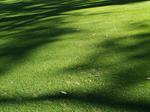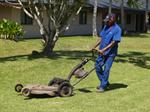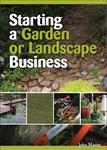LAWNS WHEN THE WATER DRIES UP!
Drought can create big problems for our lawns.
There are things you can do though; often more than most people ever think about!

The problems
Why do we have problems anyway?
- Sometimes, the lawn was created when water was not a problem; so either we have the wrong type of lawn; or the way we’ve been managing it is no longer appropriate.
- It can be hard to accept a compromise in what you expect from your lawn. If you are used to having a large lush green lawn, this may no longer be possible.
- We are not adjusting our use of lawns. Everything from home lawns to school grounds, picnic grounds, sporting facilities, and parks will deteriorate faster if they get used more.
- We are not facing the true cost of turf. If natural rainfall is diminished, turf will cost more to develop, maintain and use.
 Possible Solutions
Possible Solutions
- Change attitude (to what we want and how we use it).
- Smaller lawns (Treat some areas differently, perhaps covering with mulch, gravel or paving, and only create smaller areas of lawn of a size we can afford to maintain).
- Manage them different (eg. different practices of mowing, soil management etc).
- Change levels of tolerance (accept poorer quality turf, weeds in the lawn, etc)
- Use different grass varieties(that need less water; or tolerate poorer quality water)
- Use the lawn less (minimize wear and tear)
Dealing with Water Restrictions
If water is scarce (or expensive), you may wish to consider the following:
· Increase shading and wind protection for ponds or swimming pools. This reduces water loss, and you don’t need to top up the water as much.
· When water levels are lower in water storages, any pollutants in the water may be increased in concentration. This can apply in particular to water tanks, and even some town water storages. Consider buying in good quality drinking water at such times.
· Use more mulch and compost (organic materials insulate the soil against drying heat, and absorbs and holds moisture).
· It is generally better to water more deeply and less frequently than lightly and often. This helps ensure that the water reaches deeper in the soil profile, encouraging plant roots to go deeper. This can be particularly beneficial in times of water restrictions, or if you are for some other reason unable to water your plants, such as when you are on holiday, as deeper rooted plants are more likely to survive. Do not, however, overwater freely draining soils (in pots or the ground). If you water sand heavily, for example, most of the water you apply will drain away and be lost. Water more lightly and frequently for such soils.
· Use drip irrigation systems rather than overhead sprinklers.
· Water deeply (sink a 4 to 10cm diameter PVC pipe into the ground to create a well 30 to 60cm deep, and put water into that). This way you create a wet zone below the plant.
· Only water your plants (not the spaces between then) – a drip irrigation system can be an effective way of doing this with drippers placed only in the main part of the plants root zone.
· Water plants slowly so the water has time to soak into the ground rather than running off the surface.
· Let lawn grow a bit longer during dry periods. Frequent close mowing can actually create an increased need for water.
· Concentrate your watering on recent plantings. Older, established plants are more likely to withstand dry periods.
· Delay any new planting until cooler or wetter weather.
|
What Varieties
Some varieties of turf will tolerate dry conditions far better than others. Often these are not the high quality grasses which we are most used to, but you should consider whether it is better to have a green lawn looks a little different, or a dead lawn made from your preferred grass varieties. There are lots of choices. Here are just a few.
- Creeping Grasses such as Buffalo and Kikuyu are relatively drought tolerant
- Couch –most couch grasses are relatively drought tolerant, but some more so than others. Conquest Couch/ Native couch is more drought resistant
- Weeping Grass is an Australian native can produce a lawn that is hardier and more drought tolerant than couch; but it is slower to establish (It is also non invasive)
- Seashore Paspalum (Paspalum vaginatum) –very salt tolerant, and can be watered with salt contaminated water. A variety sold under the name “Velvetene TM” is even tolerant of occasional watering with sea water
MAINTAINING YOUR LAWN
To ensure your lawn remains in the best possible condition you will need to carry out some maintenance. The amount that you do will depend on the time and resources you have available and your level of motivation.
Maintenance Tasks
 Although mowing and watering are obvious tasks, others include; topdressing, weeding, pest control, aerating and feeding.
Although mowing and watering are obvious tasks, others include; topdressing, weeding, pest control, aerating and feeding.
Improve soil composition by adding water absorbent components to soil (eg. Water crystals, high organic materials –composts, fine mulch, Don’t smother the grass plants though).
Topdressing is sometimes done annually on high class turf, but for the average gardener this may only need to be done every 2-3 years. Topdressing is usually only needed to fill in depression areas or as a second action after spiking/coring.
Spiking/Coring is done to open the soil in order to improve aeration and water penetration. If holes are created in the soil it can help water and nutrients move deeper; and moisture that is deeper will not evaporate and be lost so readily. Ideally a small ‘core’ of soil should be removed during the process. A simple hand corer (similar in appearance to a garden fork but with hollow tines) can be obtained from some hardware and garden supplies. Coring should only be done during the active growing period.
Remove weeds that smother desirable turf; but consider retaining weeds that are hardy and enhance the turf’s ability to survive drought. In city areas, there may be less weed seed being blown about. In suburban areas, more seeds may be spread. If the lawn area is new, there may a ‘bank’ of weed seeds in the soil that need time to germinate over the years to come.
Mowing will depend on the season and type of grass grown. Mowing grass less often and a little longer can help improve the ability of a turf to deal with drought. Cool season grasses are cut as high as 4-6cm during summer but are commonly cut down to about 3-5cm in winter (depending on species). Warm season grasses are kept generally lower at about 1—2cm in height in summer and a little longer in winter.
When fertilising use the rate as recommended on the packaging. Fertilising after spiking or coring will help get the nutrients deeper into the soil; promoting deeper root growth, which is better for fighting drought. In areas where growth is vigorous, more frequent applications may be needed. In zones where seasonal rainfall is very heavy (e.g. tropics) it is best to wait till after the heaviest rainfall period is finished before applying fertiliser, otherwise most of the fertiliser is washed/leached away.
Watering – it is best to save water as much as possible. Therefore to encourage wise water usage aims to irrigate lawns less frequently with a more intense volume of water to encourage the roots of grasses to go deeper into the soil. Again, coring or spiking before watering can help the water penetrate deeper.
Learn more
Study Turf with ACS http://www.hortcourses.com/courses/product_listings.aspx?catid=Turf
VISIT OUR ACS ONLINE E BOOKSTORE
 Quality ebooks written by our staff
Quality ebooks written by our staff- Wide range of Horticulture titles by John Mason, author of over 40 gardening books, garden magazine editor, nurseryman, landscaper and principal of ACS.
- Ebooks can be purchased online and downloaded straight away.
- Read on an ipad, computer, iphone, reader or similar device.
- New titles published every month –bookmark and revisit this site regularly
- Download sample pages for free, to see what each book is like.
More from ACS
Ebook - Advice from professional horticulturists with decades in the industry.
View eBook
Ebook - Growing and using grasses and grass like plants: identify, cultivate illustrated encyclopedia
View eBook
Ebook - great resource for the professional and home gardener alike covers identification, life cycles and control methods.
View eBook